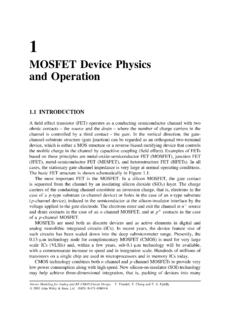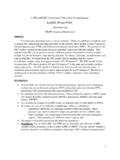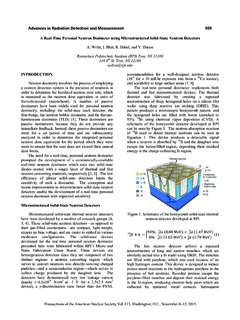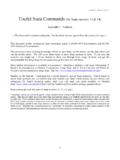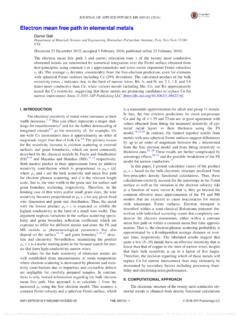Transcription of Useful Stata Commands 2019 - Rensselaer Polytechnic Institute
1 Kenneth L. Simons, 2-Oct-17. Useful Stata Commands (for Stata versions 13 & 14). Kenneth L. Simons This document is updated continually. For the latest version, open it from the course disk space.. This document briefly summarizes Stata Commands Useful in ECON-4570 Econometrics and ECON- 6570 Advanced Econometrics. This presumes a basic working knowledge of how to open Stata , use the menus, use the data editor, and use the do-file editor. We will cover these topics in early Stata sessions in class. If you miss the sessions, you might ask a fellow student to show you through basic usage of Stata , and get the recommended text about Stata for the course and use it to practice with Stata . More replete information is available in Lawrence C. Hamilton's Statistics with Stata , Christopher F.
2 Baum's An Introduction to Modern Econometrics Using Stata , and A. Colin Cameron and Pravin K. Trivedi's Microeconometrics using Stata . See: . Readers on the Internet: I apologize but I cannot generally answer Stata questions. Useful places to direct Stata questions are: (1) built-in help and manuals (see Stata 's Help menu), (2) your friends and colleagues, (3) Stata 's technical support staff (you will need your serial number), (4) Statalist ( ) (but check the Statalist archives before asking a question there). Most Commands work the same in Stata versions 12, 11, 10, and 9. Throughout, estimation Commands specify robust standard errors (Eicker-Huber-White heteroskedastic-consistent standard errors). This does not imply that robust rather than conventional estimates of Var[b|X] should always be used, nor that they are sufficient.
3 Other estimators shown here include Davidson and MacKinnon's improved small-sample robust estimators for OLS, cluster-robust estimators Useful when errors may be arbitrarily correlated within groups (one application is across time for an individual), and the Newey-West estimator to allow for time series correlation of errors. Selected GLS estimators are listed as well. Hopefully the constant presence of vce(robust) in estimation Commands will make readers sensitive to the need to account for heteroskedasticity and other properties of errors typical in real data and models. 1. Kenneth L. Simons, 2-Oct-17. Contents Preliminaries for RPI 5 A. Loading Data .. 5 A1. Memory in Stata Version 11 or Earlier .. 5 B. Variable Lists, If-Statements, and Options .. 6 C.
4 Lowercase and Uppercase Letters .. 6 D. Review Window, and Abbreviating command Names .. 6 E. Viewing and Summarizing Data .. 6 E1. Just Looking .. 7 E2. Mean, Variance, Number of Non-missing Observations, Minimum, Maximum, Etc.. 7 E3. Tabulations, Histograms, Density Function 7 E4. Scatter Plots and Other Plots .. 7 E5. Correlations and Covariances .. 8 F. Generating and Changing Variables .. 8 F1. Generating Variables .. 8 F2. Missing Data .. 8 F3. True-False Variables .. 9 F4. Random Numbers .. 10 F5. Replacing Values of Variables .. 10 F6. Getting Rid of Variables .. 10 F7. If-then-else Formulas .. 11 F8. Quick 11 F9. 11 G. Means: Hypothesis Tests and Confidence Intervals .. 11 G1. Confidence Intervals .. 11 G2. Hypothesis Tests .. 12 H. OLS Regression (and WLS and GLS).
5 12 H1. Variable Lists with Automated Category Dummies and Interactions .. 12 H2. Improved Robust Standard Errors in Finite 13 H3. Weighted Least Squares .. 13 H4. Feasible Generalized Least Squares .. 14 I. Post-Estimation Commands .. 14 I1. Fitted Values, Residuals, and Related Plots .. 14 I2. Confidence Intervals and Hypothesis 14 I3. Nonlinear Hypothesis Tests .. 15 I4. Computing Estimated Expected Values for the Dependent 15 I5. Displaying Adjusted R2 and Other Estimation Results .. 16 I6. Plotting Any Mathematical Function .. 16 I7. Influence Statistics .. 17 I8. Functional Form 17 I9. Heteroskedasticity Tests .. 17 I10. Serial Correlation Tests .. 18 I11. Variance Inflation Factors .. 18 I12. Marginal Effects .. 18 J. Tables of Regression Results.
6 19 2. Kenneth L. Simons, 2-Oct-17. J0. Copying and Pasting from Stata to a Word Processor or Spreadsheet Program .. 19 J1. Tables of Regression Results Using Stata 's Built-In Commands .. 19 J2. Tables of Regression Results Using Add-On 20 J2a. Installing or Accessing the Add-On Commands .. 20 J2b. Storing Results and Making 21 J2c. Near-Publication-Quality Tables .. 21 J2d. Understanding the Table command 's Options .. 22 J2e. Saving Tables as Files .. 22 J2f. Wide Tables .. 23 J2g. Storing Additional Results .. 23 J2h. Clearing Stored Results .. 23 J2i. More Options and Related Commands .. 23 J3. Tabulations and General Tables Using Add-On Commands .. 23 K. Data Types, When , and Missing Values .. 24 L. Results Returned after Commands .. 24 M. Do-Files and Programs.
7 24 N. Monte-Carlo Simulations .. 26 O. Doing Things Once for Each Group .. 26 P. Generating Variables for Time-Series and Panel Data .. 27 P1. Creating a Time 27 P1a. Time Variable that Starts from a First Time and Increases by 1 at Each Observation .. 27 P1b. Time Variable from a Date String .. 28 P1c. Time Variable from Multiple ( , Year and Month) Variables .. 28 P1d. Time Variable Representation in Stata .. 29 P2. Telling Stata You Have Time Series or Panel Data .. 29 P3. Lags, Forward Leads, and Differences .. 29 P4. Generating Means and Other Statistics by Individual, Year, or Group .. 30 Q. Panel Data Statistical Methods .. 30 Q1. Fixed Effects Using Dummy Variables .. 30 Q2. Fixed Effects De-Meaning .. 31 Q3. Other Panel Data Estimators .. 31 Q4.
8 Time-Series Plots for Multiple 32 R. Probit and Logit 32 R1. Interpreting Coefficients in Probit and Logit Models .. 32 S. Other Models for Limited Dependent Variables .. 34 S1. Censored and Truncated Regressions with Normally Distributed Errors .. 35 S2. Count Data Models .. 35 S3. Survival Models ( Hazard Models, Duration Models, Failure Time Models) .. 35 T. Instrumental Variables Regression .. 36 T1. GMM Instrumental Variables Regression .. 37 T2. Other Instrumental Variables Models .. 38 U. Time Series Models .. 38 U1. Autocorrelations .. 38 U2. Autoregressions (AR) and Autoregressive Distributed Lag (ADL) Models .. 38 U3. Information Criteria for Lag Length Selection .. 39 U4. Augmented Dickey Fuller Tests for Unit Roots .. 39 3. Kenneth L. Simons, 2-Oct-17.
9 U5. Forecasting .. 39 U6. Break 40 U6a. Breaks at Known Times .. 40 U6b. Breaks at Unknown Times .. 41 U7. Newey-West Heteroskedastic-and-Autocorrelation-Cons istent Standard Errors .. 42 U8. Dynamic Multipliers and Cumulative Dynamic Multipliers .. 42 V. System Estimation Commands .. 42 V1. GMM System Estimators .. 43 V2. Three-Stage Least Squares .. 43 V3. Seemingly Unrelated Regression .. 43 V4. Multivariate Regression .. 44 W. Flexible Nonlinear Estimation Methods .. 44 W1. Nonlinear Least Squares .. 44 W2. Generalized Method of Moments Estimation for Custom Models .. 44 W3. Maximum Likelihood Estimation for Custom Models .. 44 X. Data Manipulation Tricks .. 45 X1. Combining Datasets: Adding Rows .. 45 X2. Combining Datasets: Adding 45 X3. Reshaping Data.
10 48 X4. Converting Between Strings and Numbers .. 48 X5. Labels .. 49 X6. Notes .. 50 X7. More Useful Commands .. 50 4. Kenneth L. Simons, 2-Oct-17. Useful Stata (Version 14) Commands Preliminaries for RPI Labs RPI computer labs with Stata include, as of Fall 2016: Sage 4510, the VCC Lobby (all Windows PCs), and hopefully now all Dot CIO labs. To access the Stata program, use the Q-drive. Look under My Computer and open the disk drive Q:, probably labeled as Common Drive (Q:) , then double-click on the program icon that you see. You must start Stata this way it does not work to double-click on a saved Stata file, because Windows in the labs is not set up to know Stata is installed or even which saved files are Stata files. To access the course disk space, go to: \\ \classes\ECON-4570-6560\ 01 Simons.
